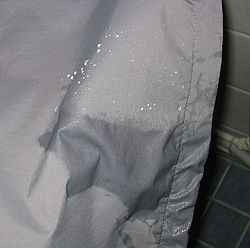
Durable Water Repellent
Encyclopedia
DWR is a coating added to fabrics at the factory to make them water-resistant (or hydrophobic
). Most factory-applied treatments are fluoropolymer
based. Durable water repellents are commonly used in conjunction with waterproof breathable fabrics
such as Gore-Tex
to prevent the outer layer of fabric from becoming saturated with water. This saturation, called 'wetting out,' can reduce the garment's breathability (moisture transport through the breathable membrane) and let water through. As the DWR wears off over time, re-treatment is recommended when necessary. Many spray-on and wash-in products for treatment of non-waterproof garments and re-treatment of proofed garments losing their water-repellency are available from sources of sporting apparel. Sprays are made by Grangers, Nikwax, McNett, Trek7, and others.
Older methods for factory application of DWR treatments involve applying a solution of a chemical onto the surface of the fabric by spraying or dipping. More recently the chemistry is applied in the vapor phase using Chemical Vapor Deposition (CVD) machinery. The advantages of CVD include: (1) It eliminates the use of hazardous and environmentally harmful solvents in the application process; (2) The process requires less chemical; (3) the waterproof layer is extremely thin and has less effect on the natural look and feel
of the fabric. Later advances have eliminated perfluorinated acids, considered to be potentially hazardous to human health by the US Environmental Protection Agency, from the application process.

Hydrophobic effect
The hydrophobic effect is the observed tendency of nonpolar substances to aggregate in aqueous solution and exclude water molecules. The name, literally meaning "water-fearing," describes the segregation and apparent repulsion between water and nonpolar substances...
). Most factory-applied treatments are fluoropolymer
Fluoropolymer
A fluoropolymer is a fluorocarbon based polymer with multiple strong carbon–fluorine bonds. It is characterized by a high resistance to solvents, acids, and bases.-History:Fluoropolymers were accidentally discovered in 1938 by Dr. Roy J...
based. Durable water repellents are commonly used in conjunction with waterproof breathable fabrics
Waterproof fabric
Waterproof fabrics are fabrics that are inherently, or have been treated to become, resistant to penetration by water and wetting. They are usually natural or synthetic fabrics that are laminated to or coated with a waterproofing material such as rubber, polyvinyl chloride , polyurethane , silicone...
such as Gore-Tex
Gore-Tex
Gore-Tex is a waterproof/breathable fabric, and a registered trademark of W. L. Gore and Associates. It was co-invented by Wilbert L. Gore, Rowena Taylor, and Gore's son, Robert W. Gore. Robert Gore was granted on April 27, 1976, for a porous form of polytetrafluoroethylene with a...
to prevent the outer layer of fabric from becoming saturated with water. This saturation, called 'wetting out,' can reduce the garment's breathability (moisture transport through the breathable membrane) and let water through. As the DWR wears off over time, re-treatment is recommended when necessary. Many spray-on and wash-in products for treatment of non-waterproof garments and re-treatment of proofed garments losing their water-repellency are available from sources of sporting apparel. Sprays are made by Grangers, Nikwax, McNett, Trek7, and others.
Older methods for factory application of DWR treatments involve applying a solution of a chemical onto the surface of the fabric by spraying or dipping. More recently the chemistry is applied in the vapor phase using Chemical Vapor Deposition (CVD) machinery. The advantages of CVD include: (1) It eliminates the use of hazardous and environmentally harmful solvents in the application process; (2) The process requires less chemical; (3) the waterproof layer is extremely thin and has less effect on the natural look and feel
Look and feel
In software design, look and feel is a term used in respect of a graphical user interface and comprises aspects of its design, including elements such as colors, shapes, layout, and typefaces , as well as the behavior of dynamic elements such as buttons, boxes, and menus...
of the fabric. Later advances have eliminated perfluorinated acids, considered to be potentially hazardous to human health by the US Environmental Protection Agency, from the application process.
Re-treating garments
Durable water-repellent finishes tend to wear off over time, and fabrics need to be re-treated to maintain water-repellency. Washing the garment first helps any DWR that remains to work better; a subsequent treatment with a 'spray-on' or 'soak-in' treatment will improve water-repellency.
See also
- P2iP2iP2i is a nano-coatings technology company, operating internationally, which has developed a family of patents in liquid-repellent nano-coatings nano-coating technology based upon UK defense research...
- Perfluorobutanesulfonic acidPerfluorobutanesulfonic acidPerfluorobutanesulfonic acid is a chemical compound with a four carbon fluorocarbon chain and a sulfonic acid functional group. As an anion it functions as a stable fluorosurfactant because of the strength of carbon–fluorine bonds....
- Perfluorooctanoic acidPerfluorooctanoic acidPerfluorooctanoic acid , also known as C8 and perfluorooctanoate, is a synthetic, stable perfluorinated carboxylic acid and fluorosurfactant. One industrial application is as a surfactant in the emulsion polymerization of fluoropolymers. It has been used in the manufacture of such prominent...
- ScotchgardScotchgardScotchgard is a 3M brand of products used to protect fabric, furniture, and carpets from stains.The original formula for Scotchgard was discovered accidentally in 1952 by 3M chemists Patsy Sherman and Samuel Smith...

